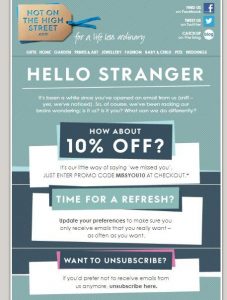Email marketing is part and parcel of most companies’ marketing strategy.
It is a much cheaper way to keep in touch with existing customers and potentially gather new ones.
It is measureable so you can monitor its return and check its effectiveness, whether you’re using it to bring in new enquiries and leads, drive sales, open doors to new contacts, or simply spread word of your business services and profile.
If it is as good as I am saying here, then everyone will be doing it – and it is fair to say that a large number of businesses are doing so, but doing it poorly.
It is imperative if you are going to go to the trouble of creating and distributing an e-newsletter or e-shot you want to give it the best chance of being opened and read by your audience.
Here are some common mistakes to avoid to give your next email marketing dispatch a fighting chance:
– Subject line – people make a decision to open an email on this so do not blow it by shouting at them with capital letters, or promising fantastic offers you can’t deliver.
Do not break the word length either – subject lines should be between 35 to 50 characters.
– Do not ramble – an e-newsletter is a snapshot of your business or specific messages you want to share.
It is not a full-blown piece of prose. Keep articles short and snappy, enticing readers to find out more by visiting your website or emailing/calling you up.
– Be selly – do not be shy to promote special offers, new services or forthcoming deals – these people have signed up to receive your email content so they will be open to promotional news too.
– If you start, do not stop – campaigns start off enthusiastically but can lose steam as ideas for content dwindle.
Create a plan and a realistic timetable and stick to it.
Ideally, e-newsletters should be monthly but smaller e-shots can be more frequent.
– Don’t chop and change – keep them regular. The best e-newsletters arrive in an email inbox at the same time of day every month.
People come to expect them and look forward to receiving them.
– Copy and paste is not good – copying direct from a Word document is dangerous as figures and symbols very often do not translate.
If you do, check the final copy carefully.
– Check names – do not get names wrong.
Basic rule in all communication but it is the biggest insult to personalise an e-document but with a wrongly spelt name!
Read more on Peterborough Telegraph
(362)







